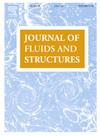浸没文丘里空化水射流载荷特性及破冰过程试验研究
IF 3.5
2区 工程技术
Q1 ENGINEERING, MECHANICAL
引用次数: 0
摘要
通过实验研究,研究了水下高压水射流在文丘里结构中的破冰机理和破冰过程。首先,分析了水下空化高压水轮机的载荷特性和流场特性,包括典型的壁面载荷时程曲线和特征相;此外,本文还对文丘里喷管的两个关键结构参数进行了优化,与非淹没状态不同,喉部长径比为1、发散角为8°的喷管对壁面载荷的承受效果最好。随后,在载荷分析的基础上,讨论了在流场扰动压力载荷和空化压力载荷共同作用下水下高压水轮机破冰过程和破坏模式。最后总结了水下状态对破冰过程的影响。研究发现,由于文丘里喉道产生的空化和水下水射流与流场相互作用的剪切作用,水下水射流在持续破冰过程中表现出良好的性能,因此有可能成为未来冰下结构破冰的辅助方法。本文章由计算机程序翻译,如有差异,请以英文原文为准。
Experimental study on load characteristic and icebreaking process of submerged Venturi cavitating water jets
This study studied the mechanism and process of ice breaking by a submerged high-pressure water jet (HPWJ) in a Venturi structure through experimental investigations. Firstly, the analysis focused on the load characteristics and flow field properties of the submerged cavitating HPWJs, including typical wall load time-history curves and characteristic phases. Furthermore, two key structural parameters of the Venturi nozzle were optimized under the parameter combination used in this study, unlike the non-submerged state, the nozzle with a throat length-to-diameter ratio of 1 and a divergence angle of 8° was the best for wall loads. Subsequently, based on the load analysis, the ice breaking process and failure modes under the combined effects of flow field disturbance pressure loads and cavitation pressure loads of the submerged HPWJ were discussed. Finally, the influence of submerged status on the ice breaking process was summarized. The research found that the submerged jets exhibited good performance during sustained icebreaking processes due to cavitation generated from Venturi throat and shear action of the submerged water jet interacting with the flow field, thus potentially serving as an auxiliary method for future subglacial structure icebreaking.
求助全文
通过发布文献求助,成功后即可免费获取论文全文。
去求助
来源期刊

Journal of Fluids and Structures
工程技术-工程:机械
CiteScore
6.90
自引率
8.30%
发文量
173
审稿时长
65 days
期刊介绍:
The Journal of Fluids and Structures serves as a focal point and a forum for the exchange of ideas, for the many kinds of specialists and practitioners concerned with fluid–structure interactions and the dynamics of systems related thereto, in any field. One of its aims is to foster the cross–fertilization of ideas, methods and techniques in the various disciplines involved.
The journal publishes papers that present original and significant contributions on all aspects of the mechanical interactions between fluids and solids, regardless of scale.
 求助内容:
求助内容: 应助结果提醒方式:
应助结果提醒方式:


